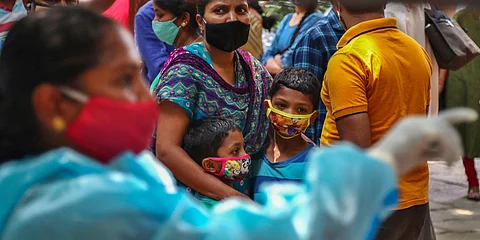

In India, Zydus Cadila’s plasmid DNA vaccine for Covid, ZyCoV-D, was given Emergency Use Authorisation (EUA) for 12–17 age group (as well as adults) in August 2021. The indigenously developed vaccine became India’s first jab to be licensed for children. Then, on October 12, the Subject Expert Committee (SEC) of the Central Drug Standard Control Organisation (CDSCO) recommended the approval of Bharat Biotech’s Covaxin for those aged 2 to 17. As the next step, it has to be cleared by the Drugs Controller General of India (DCGI). In addition, two other vaccines—Covovax (2-17 age group; Serum Institute of India) and Corbevax (5-17 age group; Biological E Ltd)—are undergoing clinical trials in children.
With the SEC giving clearance to Covaxin and the EUA being granted for ZyCoV-D, there was a lot of excitement and interest amongst parents. However, after close to two months, ZyCoV-D is yet to be rolled out for any of the age groups. The moot point here is: Do children really need Covid-19 vaccines? Also, what is the purpose of licensing a vaccine if it does not mean starting the inoculation? Let’s dive into both these issues.
SARS-CoV-2 infections occur in all age groups and therefore, the vaccines’ researchers and manufacturers conducting clinical trials on children is understandable. Then, once the trials are completed, the findings and the data are submitted to the regulatory authorities—in India the DCGI—for approval. For vaccines before the pandemic, the approval would mean that it is available in the market. However, in case of Covid-19 vaccines, since it has been an expedited process of EUA with limited and at times no follow-up data, the jabs are unavailable. So, the EUA is a process completely delinked from the programmatic roll-out of vaccines.
The decision on whether (or not), when and who should be administered the Covid-19 vaccines in India under the government programme is recommended by the National Technical Advisory Group on Immunisation (NTAGI) and needs to be endorsed by the National Expert Group on Covid-19 Vaccination (NEGVAC). One can recall that even after the EUA of two Covid-19 vaccines for adults (18 years onwards) by the DCGI in January 2021, the inoculation drives did not start immediately. The vaccines were rolled out as per the recommendations of NTAGI and NEGVAC in a phased manner—first the health staff and the frontline workers were given the jabs, then the elderly and those between 45 and 59 with comorbidities and so on.
How does the NTAGI arrive on recommendations on whether to vaccinate a specific age group? There are globally agreed-upon criteria and it has been detailed in India’s National Vaccine Policy of 2011. In the context of Covid-19 jabs for children, two considerations, namely, the risk-benefit analysis of vaccination and optimising the available supply (prioritisation) are very relevant.
The currently available vaccines in India are not proven to prevent the transmission but reduce the risk of serious illness and death. The epidemiological evidence from the last 18 months of the pandemic indicate that children do get infected at a rate nearly similar to that of adults (as also reported in the fourth nationwide sero survey in India). However, the risk of moderate to severe infection is low. Hence, the benefit of vaccinating children is lower than inoculating adults. Even though the vaccines have been given EUA after examining their safety profile through clinical trials, the ones done on children in India had been and are being done on 500 to 1,500 kids only. Such sample size is sufficient to provide an indication on the safety in context of common adverse events and immunogenicity of vaccines but falls short in identifying any such event that may occur to one in more than 1,500 vaccinees.
It is scientifically known that the rate of vaccine adverse events in general and Covid jabs in particular are inversely proportional to age. A few rare adverse events such as viral myocarditis (with mRNA-based vaccines) and blood clots (with viral vectored vaccines) are more common among the younger age groups. Therefore, the risk in Covid-19 vaccination is greater for children than adults. For instance, the clinical trial of Oxford/AstraZeneca Vaccine (AZD1222) in those aged between 5 and 17 had to be halted due to rare blood clot events in trial participants and is yet to resume. This vaccine is being administered to millions of adults in many countries. In short, the benefit of Covid-19 vaccination in children is lower and the risk is greater (than the adults). It is because of this risk-benefit analysis that only a few countries have started vaccinating children and in spite of having access to licensed vaccines and sufficient supply, have prioritised vaccination of high-risk subgroups in children.
Both ZyCoV-D and Covaxin have not been used in children outside the clinical trials. Therefore, it will be logical that India also prioritises high-risk children. A decision on vaccinating healthy children should be deferred until complete data from the trials is available. Also, data from additional vaccine adverse events of high-risk children, which will accrue over a period of time, should be factored in. Hence, Covid-19 vaccination of kids should not be influenced by political expediency or any external urgency and has to be exclusively guided by and based upon calm assessment of the data, evidence and science.
(Dr Lahariya is the co-author of ‘Till We Win: India’s Fight Against The Covid-19 Pandemic’)
Dr Chandrakant Lahariya
Physician-epidemiologist, and public policy and health systems expert
(c.lahariya@gmail.com)
(Tweets @DrLahariya)